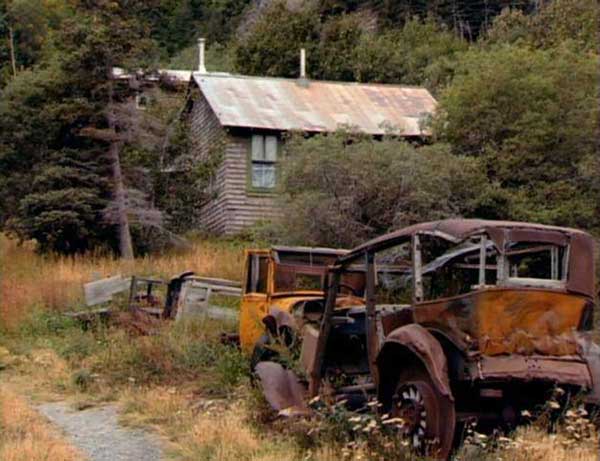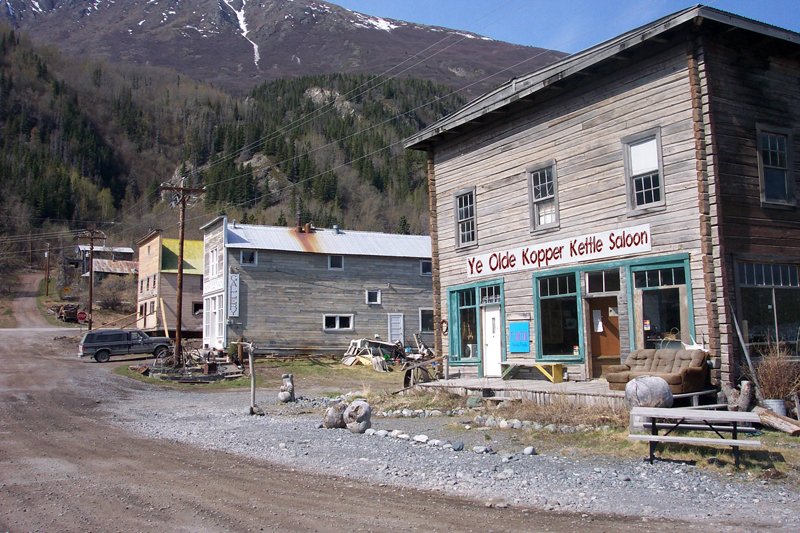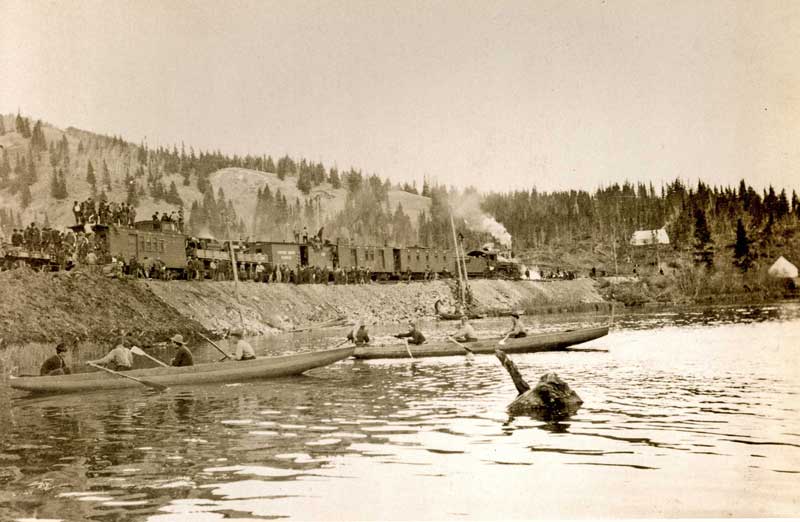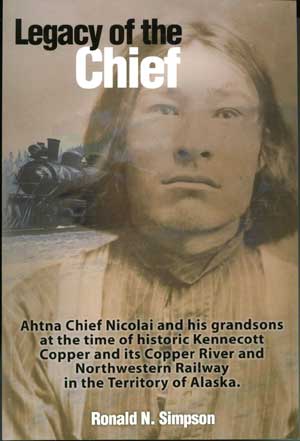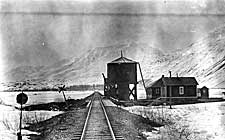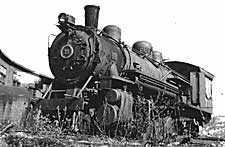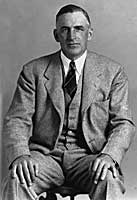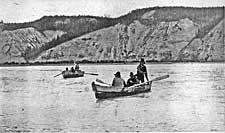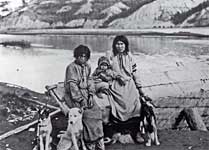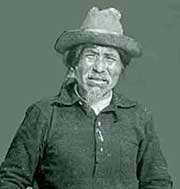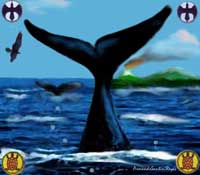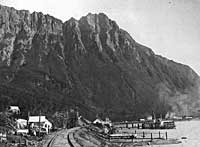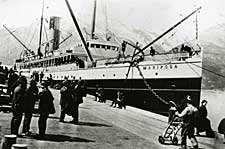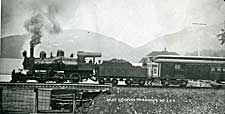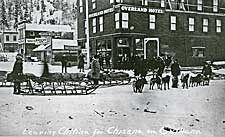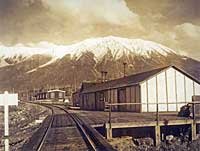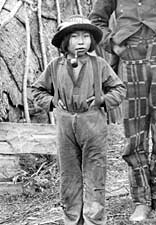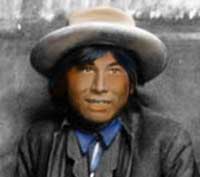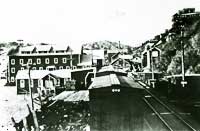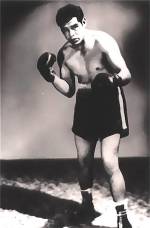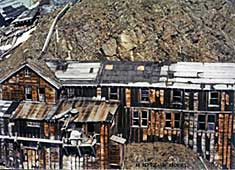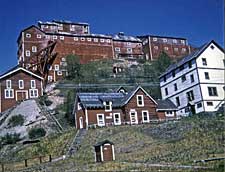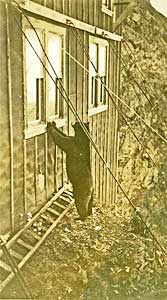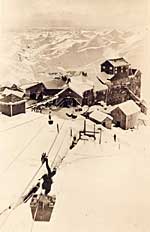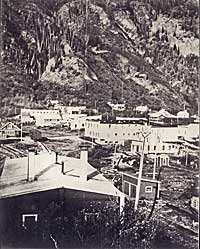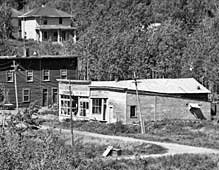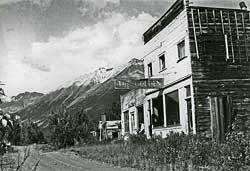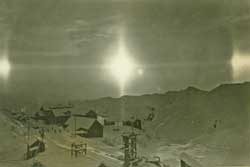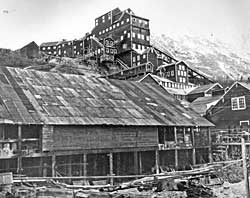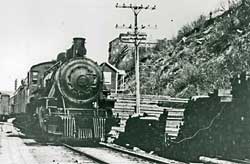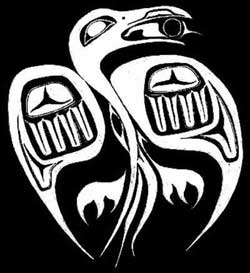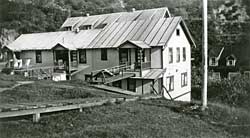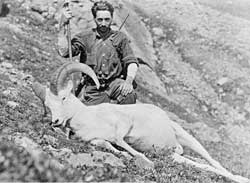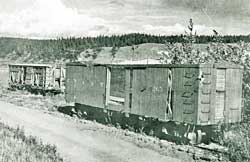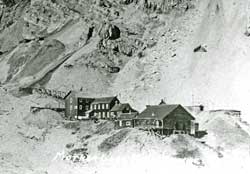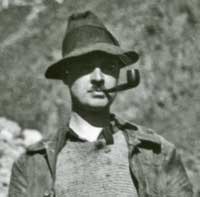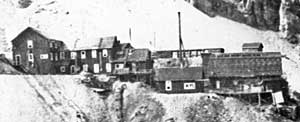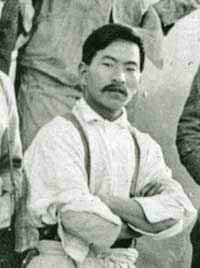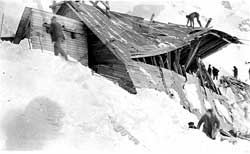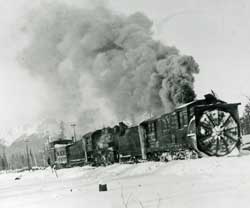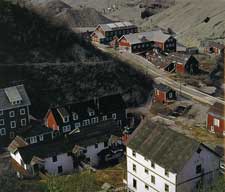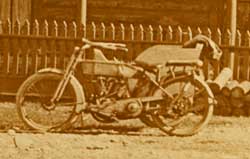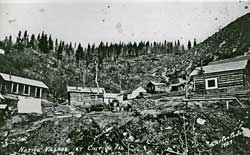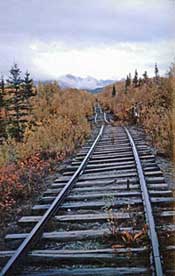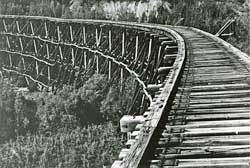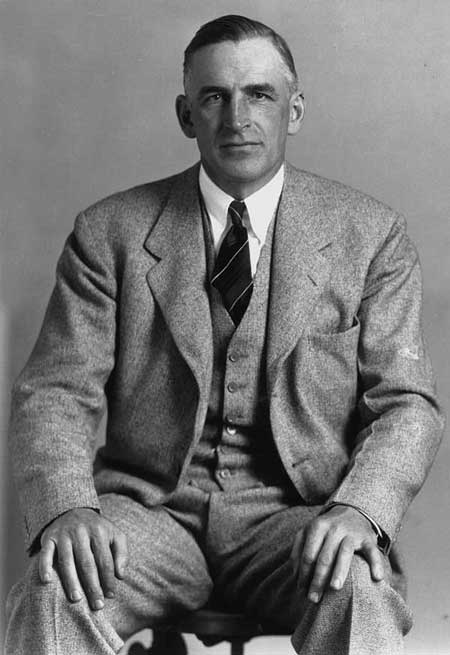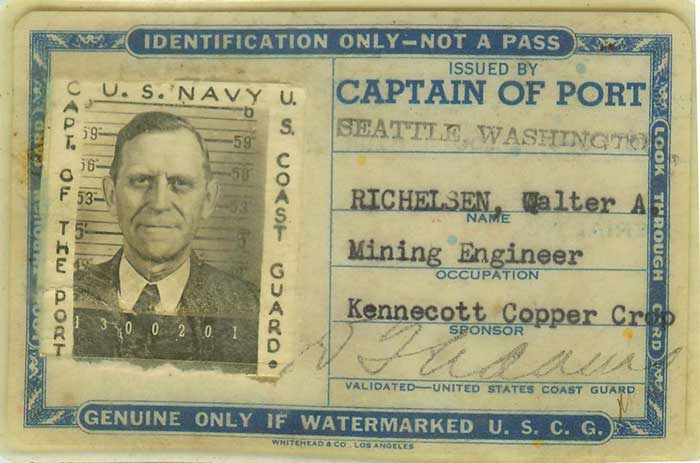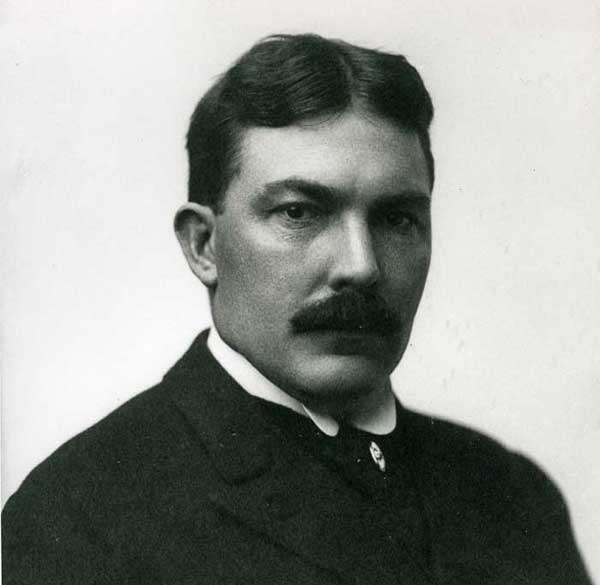Looking up the hill, south end of Main
Street, Chitina.
Street, Chitina.
This exact scene appeared in Season 6, Episode 1, in "Northern Exposure,"
the television series. This is a screen-shot from that opening scene.
the television series. This is a screen-shot from that opening scene.
As the year 2003 moved into July, it appeared that it was going to be another typically- hot, dusty summer in the lower Copper Valley. Today a grand matriarch had turned 80. Born in 1923 in the Native Village of Chittyna, she only recently retired to enjoy a quiet existence in an
apartment in the modern town of Anchorage, visiting the valley only occasionally when the weather was good and the salmon were running strong. Rosalene had enjoyed a long, notable,
sometime contentious, but always remarkable career working mostly behind the scenes but occasionally very publicly and vocally, always for her extended family, which she considered as being all of the original Native people of Alaska.
apartment in the modern town of Anchorage, visiting the valley only occasionally when the weather was good and the salmon were running strong. Rosalene had enjoyed a long, notable,
sometime contentious, but always remarkable career working mostly behind the scenes but occasionally very publicly and vocally, always for her extended family, which she considered as being all of the original Native people of Alaska.
For Rosalene, the advent of the oil pipeline in the mid-1970s brought with it many close historic parallels from the days when the Copper River & Northwestern Railway had once passed through her village. There were some hard-won lessons to be learned from those times.
Rosalene, who was already well-known in the greater Native community of Alaska, had taken it upon herself to help guide the change that came with this huge Alaskan construction
project in ways she was certain would benefit her people. Rosalene realized if someone as determined and dedicated to the cause as she was failed to force the issue, her people were almost certain to be left behind once again.
Rosalene, who was already well-known in the greater Native community of Alaska, had taken it upon herself to help guide the change that came with this huge Alaskan construction
project in ways she was certain would benefit her people. Rosalene realized if someone as determined and dedicated to the cause as she was failed to force the issue, her people were almost certain to be left behind once again.
She had seen it all before because she had lived it. She took that experience with her to Anchorage and to Juneau and even to Washington D.C., working to help bring about a Native claims settlement act that would, among other things, create the very regional corporations that she realized would be the main Native bases of power in the future. Once that battle had been won, then it would be time to work with the state legislators and directly with the oil companies in
order to ensure that those new corporations gained good contracts and that the Native people themselves had access to good training and jobs for the oil pipeline construction project which loomed ahead in the mid-1970s.
Rose, as she was known by her close relatives and friends, seldom lost a battle. Few could turn her down, such were her charms. When it came to Native politics, Rosalene was not one to cross. Yet she had a distinct preference for employing her nearly-irresistible charm in order to
advance her causes. Rosalene's charm was more often than not all that was needed to accomplish her more modest goals. Where her objectives were more ambitious or contentious, and her charm alone was not quite sufficient to close the deal , a cold, hard dose of the realities of modern-day Alaska Native politics often worked wonders. After all, those regional Native corporations, which were the legacy of a few powerful Native leaders like herself, backed her
lobbying efforts with impressive war fund chests made available to amenable candidates in select voting districts. Then there were those large Native non-profit corporations--the ones who frequently employed her services. These powerful Native entities often represented a substantial swing-vote in close elections in select districts and sometimes even statewide.
advance her causes. Rosalene's charm was more often than not all that was needed to accomplish her more modest goals. Where her objectives were more ambitious or contentious, and her charm alone was not quite sufficient to close the deal , a cold, hard dose of the realities of modern-day Alaska Native politics often worked wonders. After all, those regional Native corporations, which were the legacy of a few powerful Native leaders like herself, backed her
lobbying efforts with impressive war fund chests made available to amenable candidates in select voting districts. Then there were those large Native non-profit corporations--the ones who frequently employed her services. These powerful Native entities often represented a substantial swing-vote in close elections in select districts and sometimes even statewide.
Finally, with over three decades of fighting the good fight behind her, Rosalene concluded that it was well past time to leave all that political bargaining to the younger generations. Indeed, she felt she was losing her almost infamous sharp edge that had served her so well for so long. She could no longer keep up with the fast pace of change taking place, it seemed, everywhere in the world. Fortunately, all those years of lobbying for Native causes, especially in ensuring educational and employment opportunities for young Native people, had paid off remarkably well. As Alaska moved into a new century, the younger Natives were entering the practical world as better educated, far more politically-sophisticated, and decidedly more in tune
with a world that was changing nearly as rapidly as the one in which she had grown up during the days of the Copper River & Northwestern Railway in the Territory of Alaska. Her long tenure as a professional lobbyist for the big Native non-profits were finally over. It was time to move on, let the younger folks have their chance at political brinksmanship, settle back, and enjoy being a respected and venerated Native elder--a true matriarch representing almost all that remained of the old days.
with a world that was changing nearly as rapidly as the one in which she had grown up during the days of the Copper River & Northwestern Railway in the Territory of Alaska. Her long tenure as a professional lobbyist for the big Native non-profits were finally over. It was time to move on, let the younger folks have their chance at political brinksmanship, settle back, and enjoy being a respected and venerated Native elder--a true matriarch representing almost all that remained of the old days.
Main Street in "Beautiful downtown
Chitina"
Chitina"
Today she had let her youngest grandson talk her into visiting this dusty, unkempt bar just down the hill from her childhood home on the hill, the Native Village of Chittyna. There she sat, except for her grandson, alone in this bar, a creaky two-store log structure that once housed O. A.
Nelson's drug store in what was mockingly-known as beautiful downtown Chitina. She sat on a
rather uncomfortable stump of a barstool with minimal padding, her feet resting on an original iron rail footrest. She was ready to meet a few of her well-wishers before she headed back up the hill to the modern peeled-log community hall for the potlatch which would take place later
this evening in her honor.
rather uncomfortable stump of a barstool with minimal padding, her feet resting on an original iron rail footrest. She was ready to meet a few of her well-wishers before she headed back up the hill to the modern peeled-log community hall for the potlatch which would take place later
this evening in her honor.
But she was hoping that none of them would show up while he was here with Sonny.
It had occurred to Rosalene at this moment that she wanted nothing more than to spend some of her valuable remaining time alone with her grandson. She wanted to tell him some of the stories of those all-but-forgotten times before anyone else arrived. Grandma Rosalene's tall, somewhat gangly, long-haired grandson strongly resembled the father she so profoundly missed from all those many years ago. It was almost like looking into the face of the original "Gakona Kid," her father. Sonny's real name was MIchael, but no one ever called him that. He was named after Rosalene's deceased brother. He was the youngest of many grandchildren as well as the one who Rosalene had concluded held the most promise for ensuring the now-threatened continuation of the traditions, if not the very name, of her own Raven clan--the Saghanni-ggay.
For over thirty years Rosalene had spent her life blazing a future for her people. Sonny was a part of that future. But thanks to having grown up under the watchful tutelage of his
traditionally-minded Uncle David, who emphasized learning practical modern-day living within a traditional Native lifestyle, Sonny was firmly rooted in his Native heritage. He was a truly rare breed--a firm bridge between the future and the past. By the time Rosalene had returned to Chittyna Native Village to celebrate her 80th birthday with her relations, she had had enough of the modern world. Tonight and tomorrow and the next day she was dealing only with the past.
traditionally-minded Uncle David, who emphasized learning practical modern-day living within a traditional Native lifestyle, Sonny was firmly rooted in his Native heritage. He was a truly rare breed--a firm bridge between the future and the past. By the time Rosalene had returned to Chittyna Native Village to celebrate her 80th birthday with her relations, she had had enough of the modern world. Tonight and tomorrow and the next day she was dealing only with the past.
Her very own grandson Sonny would help her return to her roots on this very night.
"Play that song, Sonny. You know which one I like."
Sonny walked over to a jukebox that was already three decades old. Some of Sonny's friends had never even seen or heard of a 45 rpm record such as those that played in these obsolute jukeboxes. It was only because Sonny grew up in a place that still lived well in the past that he was familiar with them. The Rockola model 470 was the last jukebox of its type in the Copper Valley, maybe even in all of Alaska, that was still in commercial use in a public tavern. The owner, J.M., had decided to have this particular jukebox--one he had purchased brand new-- rebuilt for the sake of creating a sense of nostalgia--as if his Kopper Kettle Saloon needed it. J.M. could have picked a more nostalgic machine out of the 1940s or 50s or even the 60s. It
probably would have fit the motif of the bar better, to the extent that there was any theme to the place, but J.M. had a well-known soft spot for the era of the 1970s. After all, it was the big construction from that period of Alaska history which brought him and so many others to Alaska. For him those were the best times of his life--his own moments to relive while he
waited for those few customers who may or may not choose to visit the bar on any given night. So this was the jukebox he wanted--the one that almost shouted "disco-era!" The Chitina of the 1970s and later was known as a somewhat tacky place. As the local bar owner, J.M. did nothing to change that reputation. Maybe he even enhanced it. Certainly his backwoods, mostly old-hippie customers were eclectic enough and so obviously out-of-place in the modern world
just beyond the bounds of Chitina to give that impression to the casual observer.
probably would have fit the motif of the bar better, to the extent that there was any theme to the place, but J.M. had a well-known soft spot for the era of the 1970s. After all, it was the big construction from that period of Alaska history which brought him and so many others to Alaska. For him those were the best times of his life--his own moments to relive while he
waited for those few customers who may or may not choose to visit the bar on any given night. So this was the jukebox he wanted--the one that almost shouted "disco-era!" The Chitina of the 1970s and later was known as a somewhat tacky place. As the local bar owner, J.M. did nothing to change that reputation. Maybe he even enhanced it. Certainly his backwoods, mostly old-hippie customers were eclectic enough and so obviously out-of-place in the modern world
just beyond the bounds of Chitina to give that impression to the casual observer.
Sonny plunked that single quarter into the slot and pushed the buttons. One-Nine-Seven was the last song in the last row. Sonny knew it was there because the bar owner, J.M., had played it for him when Sonny had first asked if the owner had ever heard of that song. Indeed, maybe by
not so much of a coincidence, J.M. had it on this old machine. When Guns 'N Roses performed their own haunting version of this famous ballad in 1990, Sonny could hardly wait to play it for his Grandma. He was only twelve at the time, but he had a strong instinctive sense about him much as had his sleep doctor ancestors. The kid already suspected he knew the
effect it would have on Grandma Rose. He was right.
not so much of a coincidence, J.M. had it on this old machine. When Guns 'N Roses performed their own haunting version of this famous ballad in 1990, Sonny could hardly wait to play it for his Grandma. He was only twelve at the time, but he had a strong instinctive sense about him much as had his sleep doctor ancestors. The kid already suspected he knew the
effect it would have on Grandma Rose. He was right.
Rosalene loved her afternoon cocktail. After all, she had spent years as a lobbyist representing many of the great Alaska Native corporations. She had to know how to play the lobbyist game on their turf. She knew how to drink, how to stretch the experience out and enjoy it,
and, most-importantly, when to stop. All of the politicians and businessmen that she courted to her political advantage were drinkers. Many were, she suspected, alcoholics. She was not. She
would use that knowledge and skill to her advantage while never surrendering her deeply-held values. Rosalene was, above all else, a class act. She played her role--one that required bridging two worlds in a way that only she could make appear almost effortless-- exceptionally well.
and, most-importantly, when to stop. All of the politicians and businessmen that she courted to her political advantage were drinkers. Many were, she suspected, alcoholics. She was not. She
would use that knowledge and skill to her advantage while never surrendering her deeply-held values. Rosalene was, above all else, a class act. She played her role--one that required bridging two worlds in a way that only she could make appear almost effortless-- exceptionally well.
Her favorite summer drink was a blended Tequila-Gold margarita with sea salt along the rim. J.M. the Biker, bartender, and overall congenial host, had been a part of this small, middle-of-nowhere, end-of-the-road, Alaskan ghost town ever since the end of the pipeline construction days. He loved to joke about how he used to be a real bartender when there were real customers with real money along the once-busy Fourth Avenue in the downtown Anchorage of another era. J.M. certainly knew how to accommodate Rosalene's taste to absolute
perfection.
perfection.
Once she had her drink, Rosalene ordered a beer for her grandson. She did not believe that young people should be drinking much, but especially not hard alcohol. At the same time, learning "moderation in all things " was an important element of life for her. If Sonny was to survive in this white-man's world, he would have to learn to those ways and be fully prepared to beat that same white man at his own game while never forgetting who he, "Sonny" Michael Nicolai really was. She wanted so much for her grandson to succeed in both worlds, just as his great-grandfather had tried-- and almost succeeded-- to do so long
ago. After all, it was Sonny who had inherited her own father's impressive looks as well as so many of his endearing mannerisms. Rosalene fought her strong tendency of wanting to fall into the trap of seeing Sonny as a kind of reincarnation of her father Johnny. Then she had second thoughts about that.
ago. After all, it was Sonny who had inherited her own father's impressive looks as well as so many of his endearing mannerisms. Rosalene fought her strong tendency of wanting to fall into the trap of seeing Sonny as a kind of reincarnation of her father Johnny. Then she had second thoughts about that.
Today she would indulge herself, allowing her feelings to overwhelm
her more practical self. For this moment she was indeed seeing Johnny Gakona come back to life through her own grandson, even though she was not absolutely sure her father had ever really passed on. No one from the Native Village of Chittyna ever saw or heard of him again in
nearly sixty years. How could she even entertain such obviously silly notions ? If he had survived to this day against all odds he would have to be over a century old. How ridiculous. Only the truly superstitious would allow themselves to engage in such thinking. Oh, why not. Just this one time.
her more practical self. For this moment she was indeed seeing Johnny Gakona come back to life through her own grandson, even though she was not absolutely sure her father had ever really passed on. No one from the Native Village of Chittyna ever saw or heard of him again in
nearly sixty years. How could she even entertain such obviously silly notions ? If he had survived to this day against all odds he would have to be over a century old. How ridiculous. Only the truly superstitious would allow themselves to engage in such thinking. Oh, why not. Just this one time.

The Rock-ola 470 in Copper Center,
Alaska
Alaska
J.M. realized that this was going to be one of those rare moments. He could see it in Rose's eyes. J.M. told Rose he would be in his small office in the next room, when and if anyone needed him, leaving Rose alone with her grandson in the tavern. It was just them and that Rock-ola jukebox--and that song. The dusty, unpaved road outside, once known as
"Main Street," was as deserted as one would expect in a near-ghost town such as Chitina.
There were no modern buildings anywhere in the old town--just a few framed false-front structures with peeling paint interspersed with rotting log buildings, some with blank windows staring back at nothing while others were boarded-up. Then there was that one derelict boxcar, left behind when the railroad company pulled out of the Copper Valley for good some seven
decades ago. That lone boxcar until recent times had been ground zero for an annual blue grass festival put together by J.M. and a few of his mostly old hippie friends. Each year, as the alcohol flowed in great quantities, the festival became increasingly more boisterous. During one memorable festival, a dispute fueled by illegal drugs turned to violence. Guns, alcohol and drugs
proved to be a lethal combination. Two people died. So did the annual festival. So did J.M.'s attempt to revive a dying town through his once-famous annual outdoor event. Chitina's deadly reputation had returned to haunt the town. The visitors did not return.
Maybe it looked a little out-dated and out-of-place to some, but Rose admired the looks of this particular jukebox in this bar, J.M.'s "Ye Olde Kopper Kettle Saloon." Those
obsolete record-playing contraptions were becoming rare. This one was obviously a relic from the pipeline construction era when disco-themed jukeboxes were seen in all the busy rock and
disco-playing places in the downtown strips of Anchorage and Fairbanks. Roslene had not listened to one of these machines in years. Just looking and then listening to this one as it set that record on the turntable sure brought back the memories of those days when the pipeline and Big Oil was almost the only topic of the day. She loved that mechanical sound--the plunk of the quarter, the whirring sound of the records as the selection moved into position, and finally that gripper arm landing the record in place so it could play that song.
obsolete record-playing contraptions were becoming rare. This one was obviously a relic from the pipeline construction era when disco-themed jukeboxes were seen in all the busy rock and
disco-playing places in the downtown strips of Anchorage and Fairbanks. Roslene had not listened to one of these machines in years. Just looking and then listening to this one as it set that record on the turntable sure brought back the memories of those days when the pipeline and Big Oil was almost the only topic of the day. She loved that mechanical sound--the plunk of the quarter, the whirring sound of the records as the selection moved into position, and finally that gripper arm landing the record in place so it could play that song.
"Mama take this badge from me
I can't use it anymore
It's getting dark too dark to see
Feels like I'm knockin' on heaven's door . . ."
Rosalene never imagined she would take to a heavy metal band such as this one, but this performance somehow transported her back to the days when she was young girl once again, the days when legendary Native chief dealt with some of the most powerful men in the country, maybe even the world, to help his people deal with the changes brought on when a now-forgotten railroad ran through the heart of Ahtna-Athabascan country, delivering millions of tons of rich copper ore to a nation which desperately needed that copper. Because that nation was involved in a war it did not want almost in the same way that the Ahtna people found themselves dealing with change that they did not seek but could not avoid.
She was almost the last survivor of some incredibly tumultuous times, now mostly a remote memory held by only a select few. She simply could not let those memories and the hard lessons learned from them quietly die the not-so-slow death she saw as each generation moved farther away from those days. She felt compelled to pass all this on. Besides she was no longer considered a significant player in the larger world. All she had now were her memories and her stories, most particularly her family stories. Would Sonny be able to fully appreciate the tragedy and the magnificence of the story she was about to tell on this her 80th birthday ? Now was time to find out.
The late afternoon shadows had moved over the town that once was a railway center lying downhill from the Native village to its south--a somewhat dark place even during broad daylight that was wholly ringed by tall, steep hills and even high mountains to the south and west of the Native Village of Chittyna . Some went so far as to declare that the town itself and perhaps the village as well were under the spell of an old Native curse. The place certainly had a foreboding appearance to it, but who in this day and age could believe such things ? Rosalene did.
No white man, having met such a hard-headed, obviously well-grounded woman such as this would have imagined it. But it was true. Like her fellow elders, she never discussed such matters. It was en-gii. But she believed. She had lived through it . She knew it was real. All the elders knew of it, but left it alone.
As those haunting words emanated out of that old jukebox in this very-haunted place touching her very soul, she sensed a strong, unmistakable, yet familiar presence from the old days. The unseen presence of the spirit that was Chief Nicolai himself had slipped into the room. Was her
father in this room as well ? Or had Johnny Gakona transformed himself into Sonny, her most-favored grandchild, standing in front of that outdated, gaudy Rock-ola jukebox ?
father in this room as well ? Or had Johnny Gakona transformed himself into Sonny, her most-favored grandchild, standing in front of that outdated, gaudy Rock-ola jukebox ?
A new era begins as the first train ever to reach the
Alaskan interior arrives at Chitina: The Copper River & Northwestern Railway
Alaskan interior arrives at Chitina: The Copper River & Northwestern Railway
"Mama put my guns in the ground
I can't shoot them anymore
That cold black cloud is comin' down
Feels like I'm knockin' on heaven's door
Knock-knock-knockin' on heaven's door
Knock-knock-knockin' on heaven's door . . . "
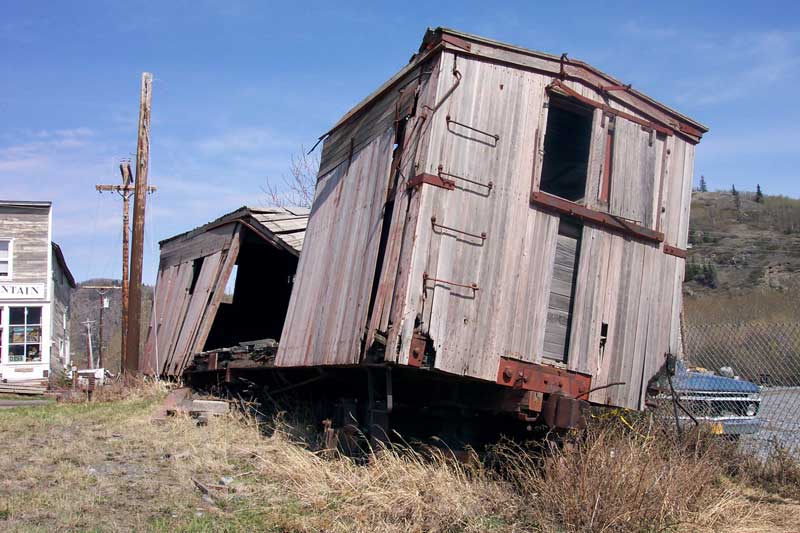 Abandoned boxcar at Chitina
Abandoned boxcar at Chitina" 'Sc'uldzesde tsuun !"
Had he not heard what she just called him? He did not even flinch. He just
motioned to her to join him on the dusty old dance floor with unspoken words.
"Come here. Join me on this floor. Let us
dance the dance.
people who were always here and who always will be here--even to the end, to the last days given us by the Great Creator.
"We are the true guardians of the earth.
"We are the Children of the Earth.. We are the People of the Saghanni-ggay. "
Rosalene raised up from her seat as if she was only sixteen once again, joining
in an ancient dance with her grandson. And with all of her unseen relations--
while from the shadows the spirit of Nicolai quietly watched and silently
applauded.
The stories could wait.
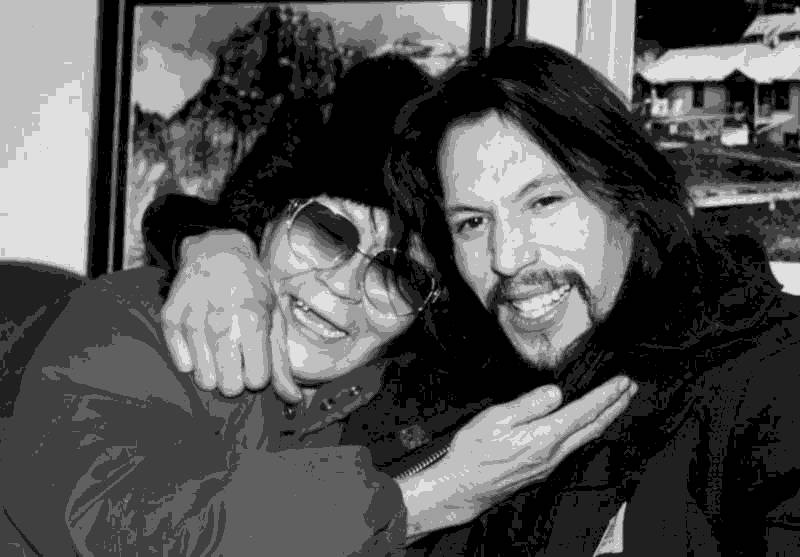
Guns 'n Roses: Knockin' on
Heaven's Door
Copper River Natives,
circa the Turn of the Century
circa the Turn of the Century
